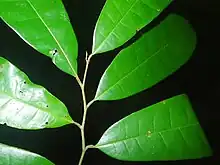Meiocarpidium lepidotum
Meiocarpidium lepidotum is a species of plant in the family Annonaceae. It is native to Cameroon, The Central African Republic, The Republic of the Congo, and Gabon.[2] Daniel Oliver, the English botanist who first formally described the species using the basionym Unona lepidota, named it after rust-colored, shiny scales (Latinized form of Greek λεπίς, lepis)[3] on its branchlets, the underside of its leaves and its buds.[4]
| Meiocarpidium lepidotum | |
|---|---|
 | |
| Photograph of the leaves of Meiocarpidium lepidotum.[1] | |
| Scientific classification | |
| Kingdom: | Plantae |
| Clade: | Tracheophytes |
| Clade: | Angiosperms |
| Clade: | Magnoliids |
| Order: | Magnoliales |
| Family: | Annonaceae |
| Genus: | Meiocarpidium |
| Species: | M. lepidotum |
| Binomial name | |
| Meiocarpidium lepidotum | |
| Synonyms | |
|
Unona lepidota Oliv. | |
Description
It is a tree reaching 25 feet in height. Its leathery leaves are 5-7 by 1.5-2 inches, and smooth on their upper surface. Its solitary flowers occur in extra-axillary positions and are bisexual. Its 3 sepals are oval to triangular in shape with edges that touch one another. It has 6 cream-colored petals arranged in two rows of three. The petals are roughly equal in size an have been observed adhering to one another at their apices to form a chamber around the reproductive structures. Its flowers have numerous stamen. Its flowers have 3-5 carpels. Its ovules are arranged in to rows positioned ventrally in ovaries. Its fruit have numerous seeds in a single row. The brown seeds are oval, rounded on one side and angled on the other.[4][5][6]
Reproductive biology
The pollen of M. lepidotum is shed as permanent tetrads.[7]
Uses
Bioactive molecules extracted from its bark have been reported to have analgesic, anti-inflammatory and antidepressant activities in tests with mice.[8]
References
- "Meiocarpidium lepidotum Engl. & Diels". Tropicos. Tropicos.org. Missouri Botanical Garden. n.d. Retrieved August 3, 2023.
- "Meiocarpidium lepidotum (Oliv.) Engl. & Diels". Plants of the World Online. The Trustees of the Royal Botanic Gardens, Kew. n.d. Retrieved February 10, 2019.
- Stearn, William (2004). Botanical Latin. Portland, Ore. Newton Abbot: Timber Press David & Charles. ISBN 9780881926279.
- Oliver, Daniel (1868). Flora of tropical Africa. Vol. 1. London: L. Reeve and Co. p. 36.
- Engler, A.; Diels, L. (1900). "Anonaceen und Beschreibung Einiger Neuen Gattungen Dieser Familie aus dem Tropischen Afrika". Notizblatt des Königlichen botanischen Gartens und Museums zu Berlin (in German and Latin). 3: 45–59. doi:10.2307/3993968. JSTOR 3993968.
- Saunders, Richard M. K. (2012). "The diversity and evolution of pollination systems in Annonaceae". Botanical Journal of the Linnean Society. 169 (1): 222–244. doi:10.1111/j.1095-8339.2011.01208.x. ISSN 0024-4074.
- Walker, James W. (1971). "Pollen Morphology, Phytogeography, and Phylogeny of the Annonaceae". Contributions from the Gray Herbarium of Harvard University. 202 (202): 1–130. doi:10.5962/p.272704. JSTOR 41764703. S2CID 249081277.
- Bouchra, Meddah; Mamadou, Godefroy; Tiendrebeogo, Ry; Limas-Nzouzi, Nicolas; Miantezila, Joe; Cherrah, Yahia; Faouzi, My A; Eto, Bruno (2013). "Analgesic, Anti-inflammatory and Antidepressant Activities of Triterpene from Meiocarpidium lepidotum (Annonaceae) Bark" (PDF). International Journal of Phytopharmacology. 4 (2): 133–140.